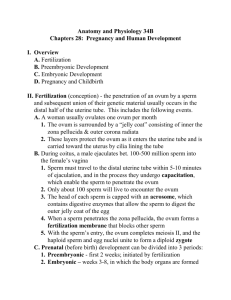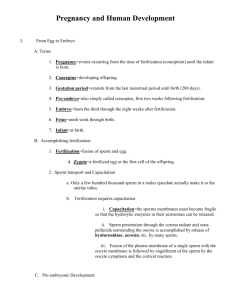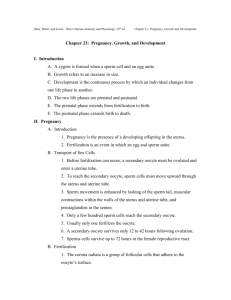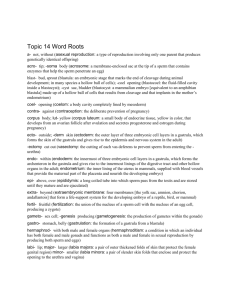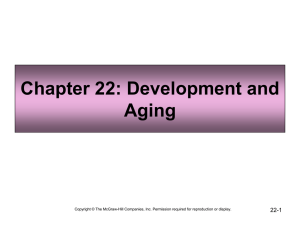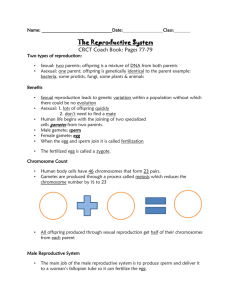Reproduction & Development
advertisement
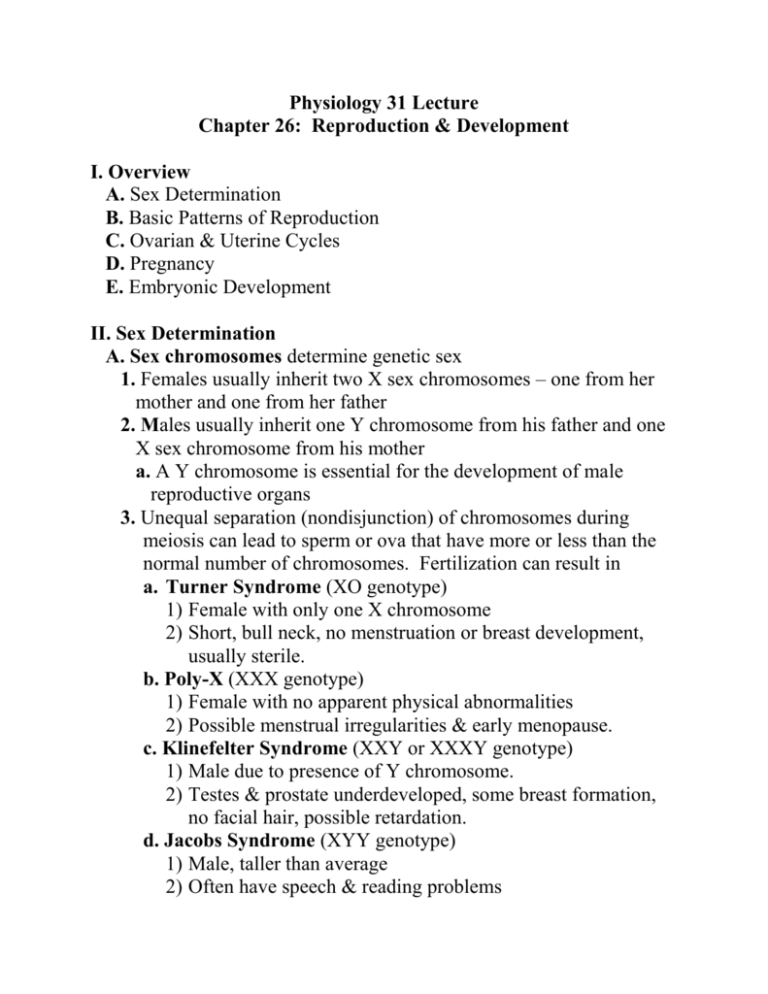
Physiology 31 Lecture Chapter 26: Reproduction & Development I. Overview A. Sex Determination B. Basic Patterns of Reproduction C. Ovarian & Uterine Cycles D. Pregnancy E. Embryonic Development II. Sex Determination A. Sex chromosomes determine genetic sex 1. Females usually inherit two X sex chromosomes – one from her mother and one from her father 2. Males usually inherit one Y chromosome from his father and one X sex chromosome from his mother a. A Y chromosome is essential for the development of male reproductive organs 3. Unequal separation (nondisjunction) of chromosomes during meiosis can lead to sperm or ova that have more or less than the normal number of chromosomes. Fertilization can result in a. Turner Syndrome (XO genotype) 1) Female with only one X chromosome 2) Short, bull neck, no menstruation or breast development, usually sterile. b. Poly-X (XXX genotype) 1) Female with no apparent physical abnormalities 2) Possible menstrual irregularities & early menopause. c. Klinefelter Syndrome (XXY or XXXY genotype) 1) Male due to presence of Y chromosome. 2) Testes & prostate underdeveloped, some breast formation, no facial hair, possible retardation. d. Jacobs Syndrome (XYY genotype) 1) Male, taller than average 2) Often have speech & reading problems 2 B. Sexual Differentiation occurs in the second month of development 1. Embryonic structures that will differentiate into the genitals include a. Genital tubercle – becomes the glans penis or the clitoris b. Urethral folds & groove – becomes penis shaft or labia minora and vestibule c. Labioscrotal swellings become scrotum or labia majora d. Gonad cortex forms the ovaries e. Gonad medulla forms the testes f. Wolffian duct becomes the epididymis, vas deferens, and seminal vesicle (testosterone and Anti-Mullerian hormone present) g. Mullerian duct becomes the Fallopian tube, uterus, cervix, and upper vagina (Anti-Mullerian hormone absent) 2. What determines whether the embryonic structures become male or female genitals? The presence or absence of the Y chromosome! 3. The Y chromosome contains the SRY gene, which codes for testis-determining factor (TDF) protein a. TDF binds to DNA and activates other genes, which b. Produce proteins that direct the formation of the testes from the gonads 4. At 8-9 weeks development, the testes begin to secrete testosterone and dihydrotestosterone (DHT), which influence the development of the male reproductive structures a. Pseudohermaphrodites are males who inherit a defective gene for the enzyme that converts testosterone to DHT, which causes the genitals to look female until puberty 5. In the absence of a Y chromosome, embryonic reproductive tissues become female gonads and genitalia 3 III. Basic Patterns of Reproduction A. Gametogenesis begins in the uterus and resumes during puberty 1. Both male and female gonadal germ cells undergo meiosis to produce gametes, but their timing differs 2. Male testes are inactive until puberty, when FSH from the pituitary gland stimulates spermatogonia to become sperm 3. Oogonia in the embryonic ovaries undergo mitosis and meiosis, prophase I to form primary oocytes (2n) by the 5th month of embryonic development 4. At puberty, some primary oocytes are stimulated by FSH to complete meiosis I to form a large secondary oocyte (n), and smaller polar body (n) 5. The secondary oocyte begins meiosis II, but stops at metaphase II, until it is fertilized by a sperm (the polar body dissolves) 6. If the secondary oocyte is fertilized after ovulation, then it completes meiosis II, forming a second polar body in addition to the zygote (united nuclei of egg and sperm) 7. Note that in males, each primary spermatocyte produces 4 viable sperm via meiosis, but in females, each primary oocyte produces only one viable ovum and 2 nonfunctional polar bodies. B. The brain directs reproduction via hormonal pathways 1. GnRH is secreted by the hypothalamus to the pituitary gland 2. The pituitary gland responds by secreting FSH and LH, which travel to the gonads 3. FSH stimulates a. Follicle (oocyte and surrounding cells) enlargement and estrogen production in the ovaries b. Sperm production in the testes by influencing Sertoli (sustentacular) cells that provide nourishment to spermatogonia 4. LH stimulates a. Ovulation and progesterone production in the ovaries b. Testosterone production in the testes’ interstitial (Leydig) cells 5. Estrogen and progesterone stimulate the uterus to build and maintain the endometrial lining in preparation for a fertilized egg 4 5. Rising levels of estrogen from the ovaries causes a negative feedback, inhibiting the release of FSH IV. Ovarian & Uterine Cycles A. During the uterine cycle, the endometrial lining of the uterus is built up, then shed via the process of menstruation (menses) 1. Menses (days 1-6) – shedding of the endometrial lining 2. Proliferative phase (days 7-14) - the endometrial stratum functional is rebuilt by the underlying vascular layer, the stratum basal, stimulated by estrogen 3. Secretory phase (days 15-28) – after ovulation, hormones from the corpus luteum cause the stratum functional to develop secretory glands B. The ovarian cycle corresponds to the uterine cycle and is divided into 3 phases: follicular, ovulation, and luteal 1. Follicular phase (days 1-13) – development of follicles a. FSH stimulates a few primary follicles to develop into secondary follicles b. Follicular granulosa cells surrounding the primary oocyte secrete estrogen c. Rising estrogen levels stimulate the proliferative phase in the uterus, inhibit FSH secretion, and increase LH secretion d. LH causes one secondary follicle to enlarge rapidly to form a mature Graafian follicle 2. Ovulation (about day 14) – the Graafian follicle ruptures and releases the oocyte to be swept into the Fallopian tube 3. Luteal phase (about days 15-27) a. The remaining cells of the ruptured follicle become a corpus luteum, which b. Secretes progesterone and estrogen to build and maintain the endometrium in preparation for possible pregnancy c. If the oocyte is not fertilized, the corpus luteum degenerates into a nonfunctional corpus albicans, endometrial arteries constrict, and menstruation begins 5 V. Pregnancy A. Fertilization requires capacitation 1. After sperm mature in the epididymis and are ejaculated, they must undergo capacitation 2. Capacitation occurs in the female reproductive tract, where the sperm develop the ability to swim fast and fertilize the egg 3. A sperm’s head is covered with an acrosome cap, which contains digestive enzymes to help it penetrate the egg 4. The egg is surrounded by a “jelly coat” consisting of the corona radiata (granulosa cells) and a glycoprotein layer (zona pellucida) 5. Of the millions of sperm ejaculated, only about 100 will reach the egg, and only one will enter the egg 6. Once a sperm penetrates the outer egg layers, it binds to receptors and enters the egg, where the sperm and egg nuclei fuse to form a diploid zygote 7. A fertilization membrane forms around the egg that prevents any other sperm from entering B. The blastocyst implants in the endometrium 1. As the zygote travels through the Fallopian tube toward the uterus, it divides via mitosis to form a a. Morula – solid ball of about 16-32 cells, which continues to divide to become a b. Blastocyst – hollow ball of about 100 cells, which consists of 1) Trophoblast – outer layer of cells that will become the chorion that encloses the embryo and forms the placenta 2) Inner cell mass that will become the embryo and other extraembryonic membranes 2. Implantation in the uterine lining begins between the 5th & 7th day after fertilization a. The blastocyst embeds itself in the endometrium b. The trophoblast secretes enzymes that digest a portion of the endometrium 6 c. Endometrial cells cover the embedded blastocyst d. Fingerlike projections extend from the trophoblast into the endometrium e. Human chorionic gonadotropin (HCG) secreted by the trophoblast maintains the corpus luteum so it continues to produce progesterone to maintain the endometrium f. HCG production declines by the 10th week when the developing placenta begins to produce estrogen & progesterone to maintain the endometrium C. Formation of the 3 Germ Layers begins during the 3rd week 1. An amniotic cavity forms between the inner cell mass & trophoblast 2. The inner cell mass flattens into an embryonic disk and forms 3 germ layers: a. The upper ectoderm, near the amniotic cavity b. The lower endoderm, near the blastocyst cavity c. Later, the mesoderm forms between ectoderm & endoderm 3. When all 3 germ layers are formed, the individual is an embryo VI. Embryonic Development A. During the embryonic period (3-8 wk), all of the body tissues & organs form, as well as the placenta, umbilical cord, & extraembryonic membranes B. Germ layers differentiate into different tissues 1. Ectoderm (outer layer) eventually becomes: a. Epidermis of the skin and its derivatives b. Nervous tissue - brain, spinal cord, sense organs, pituitary gland, & adrenal medulla 2. Mesoderm (middle layer) differentiates to form: a. Muscle - smooth, cardiac, & skeletal b. Connective tissue - cartilage, bone, ligaments, & blood c. Dermis of the skin 7 d. Epithelial lining of blood vessels, body cavities, joint cavities e. Notochord, which becomes the intervertebral discs f. Gonads, kidneys, ureters, and adrenal cortex 3. Endoderm (inner layer) eventually forms: a. Epithelial lining (mucous membranes) of digestive sys., respiratory sys., urinary bladder & urethra, and vagina b. Liver & pancreas C. Extraembryonic membranes outside the embryo include the amnion, yolk sac, allantois, and chorion 1. Amnion - thin membrane derived from ectoderm and mesoderm, it surrounds the embryo, forming an amniotic sac filled with amniotic fluid. a. Functions include: 1) Ensures symmetrical growth & development 2) Cushions & protects the embryo/fetus 3) Helps maintain a constant pressure & temperature 4) Permits freedom of fetal movement b. Amniotic fluid is composed of fluids from maternal blood plasma, fetal urine, and cells sloughed off by the fetus c. In amniocentesis, amniotic fluid is withdrawn by syringe (at 14-15 wks), then the cells are tested for genetic abnormalities 2. Yolk sac - established from cells on the underside of the embryonic disc during the end of the 2nd week a. Does not contain nutritive yolk b. Produces blood cells until the liver forms the 6th week c. Primordial germ cells form from the yolk sac wall, then migrate to the gonads to form spermatogonia or oogonia d. Folds with the embryonic disc to become the primitive digestive tract and part of the umbilical cord 3. Allantois - forms during the 3rd week as a small outpocketing of the posterior end of the yolk sac 8 a. Gives rise to the umbilical cord b. Becomes part of the urinary bladder 4. Chorion - outermost extraembryonic membrane a. Becomes the fetal half of the placenta as fingerlike villi extend into the endometrium b. The villous chorion forms embryonic blood vessels; as the embryonic heart forms, the blood is circulated close to the uterine wall c. In chorionic villus sampling, a sample of chorionic villus is obtained (at 10-12 wks), then is tested for genetic abnormalities D. Placenta - vascular structure formed from both maternal & embryonic tissues that attach the fetus to the mother’s uterus 1. The placenta forms from day 11 through week 12, with most development during the embryonic period 2. As chorionic villi digest their way through uterine blood vessels, eventually forming a blood filled cavity called the placental sinus 3. The chorionic villi grow into vascular branched structures surrounded by maternal blood in the sinus 4. Blood does not flow directly between mother & fetus, rather substances diffuse across the shared placental membrane a. Oxygen and nutrients diffuse across the placenta from mother to fetus via blood in the umbilical vein b. CO2 and wastes diffuse from fetus to mother via blood carried by the umbilical arteries c. The placenta’s blood barrier prevents some large pathogens from diffusing but allows smaller pathogens, such as drugs, viruses, some bacteria, and maternal antibodies 5. The placenta also functions as an endocrine gland, secreting both glycoproteins and steroid hormones to maintain the endometrium. 9 E. Umbilical cord - connects the fetus to the placenta and contains 2 umbilical arteries & 1 umbilical vein F. Major structural changes in the embryo by week 1. Third week – gastrulation & nerulation occur a. A linear band called the primitive streak occurs along the dorsal midline of the embryonic disk and cells invaginate b. This gives rise to the primitive node at the cranial end, which gives rise to the mesoderm of the head and notochord c. The notochord and somites form along the midline axis to begin formation of the embryonic skeleton and muscles d. Along the dorsal midline ectoderm above the notochord a neural plate forms, which folds into a neural groove, then a neural tube, from which the brain and spinal cord develop 2. Fourth week – embryo folds into a tadpole shape, germ layers differentiate into specialized tissues a. A connecting stalk that will become the umbilical cord forms from the embryo to the placenta b. The heart begins to beat c. Head & jaws become apparent d. Primordial eyes, brain, spinal cord, lungs, & digestive organs develop e. Superior & inferior limb buds are seen as small swellings 3. Fifth week a. The head enlarges and the developing eyes, ears, and nasal pits become obvious b. Appendages form from the limb buds, with paddle shapedhand & foot plates 4. Sixth week a. The head is larger than the trunk b. The brain is undergoing extensive differentiation c. Limbs lengthen and are flexed, with notches appearing between the digital rays in the hand & foot plates 10 5. Seventh & eighth weeks a. Body organs are formed b. The nervous system is starting to coordinate body activity c. Neck is apparent d. Eyes are well developed, but lids are stuck together e. Nostrils are developed but plugged with mucus f. External genitalia are formed, but still undifferentiated g. All body systems are developed (but still immature) by the end of the 8th week h. From this time on, the embryo is called a fetus G. The developing embryo/fetus is particularly susceptible to teratogens (birth defect causing substances) during the first trimester (first 3 months of development). 1. Alcohol causes more birth defects than any other drug, and can cause fetal alcohol syndrome, which is characterized by a small head and mental retardation 2. Cigarette smoking contributes to fetal and infant mortality. Women who smoke while pregnant have twice as many miscarriages as those who do not smoke 3. All drugs should be avoided during pregnancy, unless prescribed by a physician who knows the woman is pregnant


